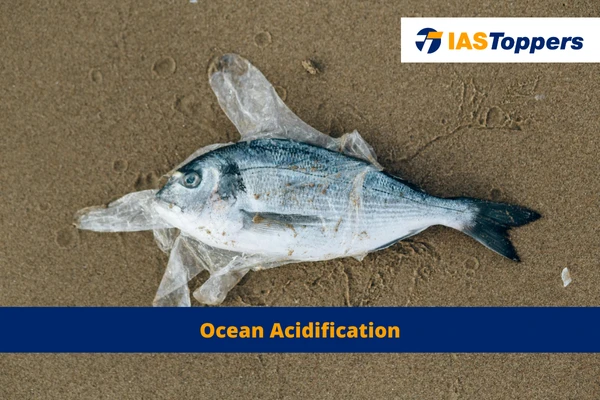Ocean acidification is a natural process in which the acidity of seawater increases as it absorbs excessive carbon dioxide from the atmosphere. The rising carbon dioxide levels, primarily caused by human activities, have led to a decline in ocean surface pH, affecting marine organisms and ecosystems. Finding solutions to reduce carbon dioxide emissions and promote awareness are crucial to mitigate the harmful impacts of ocean acidification on both marine life and human well-being
Ocean Acidification will be helpful for UPSC IAS Exam preparation. GS Paper-3 Environment.
Table of Content
- What is Ocean Acidification?
- Impact of Ocean Acidification
- Impact of Ocean Acidification on Humans
- Ocean Acidification Solutions
- Conclusion
- Frequently Asked Questions (FAQs)
What is Ocean Acidification?
- Definition: Ocean acidification is the process in which seawater becomes more acidic due to the excess carbon dioxide (CO2) it is absorbing from the atmosphere.
- The average pH of the ocean surface fell from approximately 8.15 to 8.05 between 1950 and 2020.
- Carbon dioxide emissions from human activities are the primary cause of ocean acidification, with atmospheric carbon dioxide levels exceeding 410 ppm.
- It is a reduction in the pH of the ocean over an extended period, caused primarily by an increase of carbon dioxide from the atmosphere.

Impact of Ocean Acidification
- It is impacting every ocean on Earth, as well as coastal estuaries and other waterways.
- Decreased ocean pH has a range of potentially harmful effects for marine organisms, including reduced calcification, depressed metabolic rates, lowered immune responses, and reduced energy for basic functions such as reproduction.
- Ocean acidification may force some organisms to reallocate resources away from growth and reproduction to maintain basic physiological functions.
- Ocean acidification also effects the ocean’s chemistry, including the lowering of seawater pH and carbonate saturation that results from increasing atmospheric CO2 concentrations.
Impact of Ocean Acidification on Humans
- It can affect human health in many ways, including through the accessibility and quality of food, air, medicine etc.
- The acidification of ocean water leads to the growth of harmful algae, which can cause respiratory issues and disrupt nature-based resources.
- It can impact the economy and livelihoods of people who depend on the fishing and shellfish industries.
- The increase in carbon dioxide levels in the atmosphere, which is the primary cause of ocean acidification, is also a concern for human health.
Ocean Acidification Solutions
- Reduce carbon dioxide emissions from human activities.
- Increase the use of renewable energy sources, such as wind and solar power, to reduce the amount of carbon dioxide released into the atmosphere.
- Implement policies and regulations to limit carbon dioxide emissions and promote sustainable practices.
- Increase public awareness and education about the impacts of ocean acidification and the importance of reducing carbon dioxide emissions.
- Develop and implement technologies to capture and store atmospheric carbon dioxide.
- Grow sea plants such as kelp and eelgrass, which can effectively absorb carbon dioxide and reduce acidity in the ocean.
- Restore or farm sea plants to soak up atmospheric carbon and reduce acidity in the ocean.
- Explore and implement geoengineering strategies to reduce ocean acidification, such as adding the building blocks for shells or chemically absorbing carbon dioxide.
Conclusion
The effects of ocean acidification on marine organisms and the potential risks to human health and livelihoods highlight the urgency to address this issue. By reducing carbon dioxide emissions, promoting renewable energy sources, and implementing various mitigation strategies, we can strive towards safeguarding our oceans and preserving their delicate ecosystems for future generations.
Ref: Source-1
| Other Articles in Environment & Disaster Management | |
| Harmful Algal Blooms | Eutrophication |
| Microplastics | Eco Sensitive Zone (ESZ) in India |
| Plastic Waste Management | Liquid Nano Urea |
FAQs (Frequently Asked Questions)
What is the primary cause of ocean acidification?
The Primary cause of ocean acidification is Carbon dioxide emissions from human activities.
How to measure ocean acidification?
Researchers use ships, stationary buoys and floats to measure ocean acidification by measuring pH of larger bodies of water. They uses sensors which are lowered into the ocean for some time so researchers can receive ongoing data on pH levels.


